Introduction
The Art Nouveau style was popular at the end of the 19th and the beginning of the 20th century. It originated in Europe and challenged the Victorian style with its austerity and restraint of colors and shapes (“Ashby, C. (2021). Art Nouveau: Art, architecture and design in transformation. London, England: Bloomsbury Publishing”). Art Nouveau is exceptionally decorative and refers to natural motifs. The main elements of the style are bright colors, floral themes, ornaments, and the use of light, texture, and new materials for the creation of flowing shapes.
Glassware
Glassware is one of the most prominent examples of the Art Nouveau style. Tiffany Glass, as a product of Tiffany Studios, became the symbol of the American Art Nouveau movement (“Aigner, C. J. (2020). Artistic glass: One studio and fifty years of stained glass. Ottawa, Canada: ECW Press”). It used natural themes, vibrant colors, and light to create bright but flowing designs. Tiffany Studios created lamps on a bronze base with lampshades made of special stained glass, as well as large stained-glass compositions. All their work included floral or botanical motifs, including flowers, butterflies, dragonflies, and others. Compositions usually featured landscapes depicting nature in bright colors and with great details.
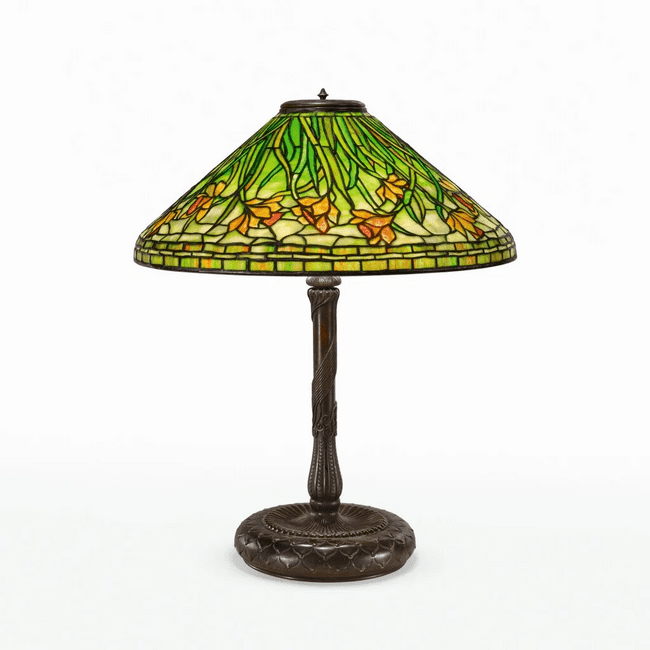
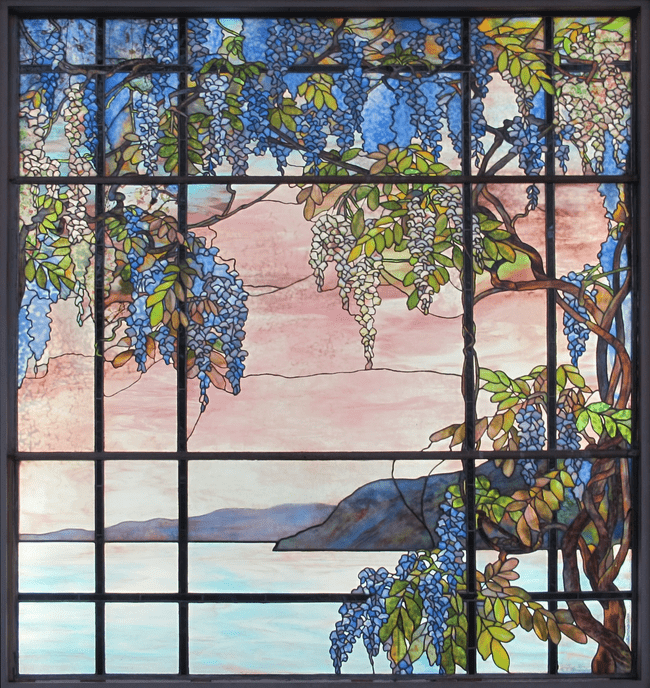
Jewellery
Art Nouveau style designers were also actively experimenting with various materials and techniques to create jewelry. The jewelry of this movement depicted decorative elements inspired by natural motifs and did not focus on the preciousness of the materials. A distinctive feature of Art Nouveau jewelry designers was the use of amber, enamel, glass, horn, and others (“Ashby, C. (2021). Art Nouveau: Art, architecture and design in transformation. London, England: Bloomsbury Publishing”). These materials allowed to creation a unique interplay of texture, light and color, which became the basis of the style. Typical themes were also nature, flowers, graceful women, and mythical creatures.
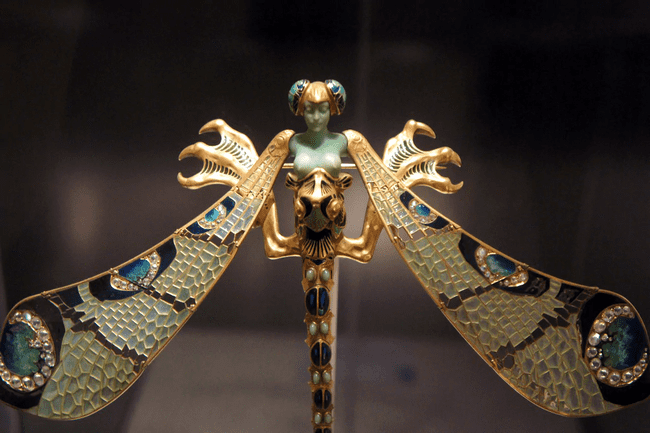
Posters and Graphic Art
With the development of new printing technologies, including lithography and color printing, it became possible to create edition illustrations and posters. Artists predominantly depicted women as a symbol of modernity and beauty. The posters and illustrations also featured floral and natural elements, vibrant colors, and two-dimensional composition. A distinctive feature of posters and illustrations of the Art Nouveau style are smooth, fluid forms and clear contours, referring to stained glass compositions (“Ashby, C. (2021). Art Nouveau: Art, architecture and design in transformation. London, England: Bloomsbury Publishing”). The illustrations were filled with ornaments but completely devoid of depth.
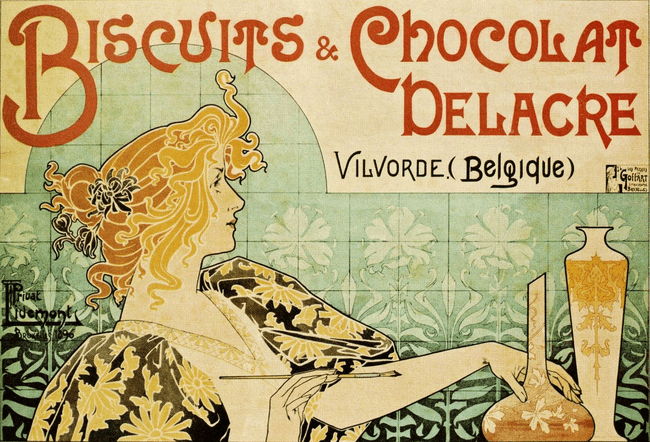
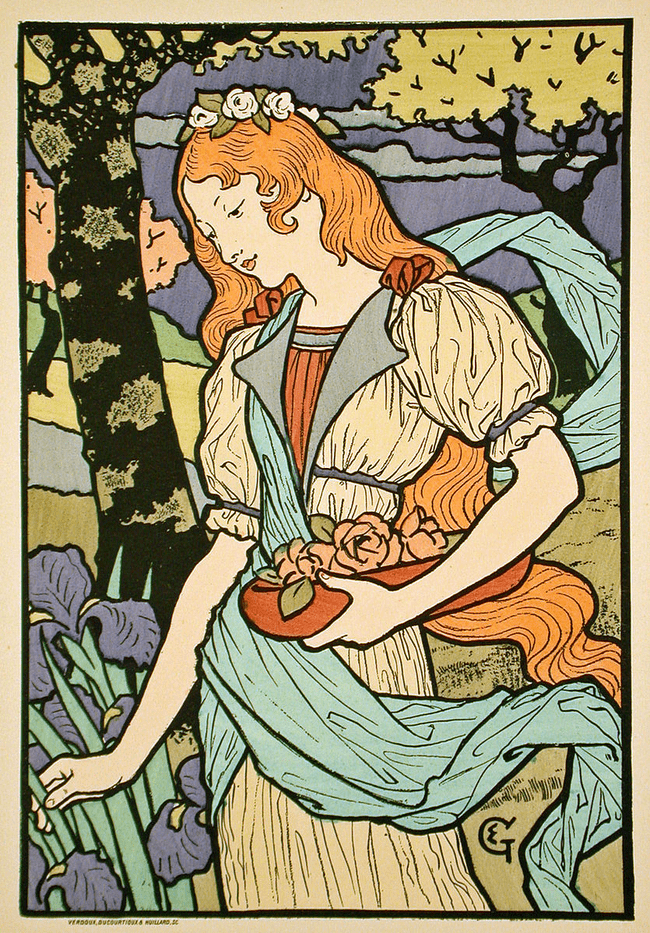
Painting
If the illustrations and posters were intended for use in advertising and on the streets, some Art Nouveau artists were still involved in creating traditional paintings. One of the most prominent examples of paintings of this movement are works by Gustav Klimt. His paintings were distinguished by their decorative style, the use of flowing forms, bright colors, ornaments, and floral motifs. The center of the plots of Klimt’s paintings, as well as the graphic art of the Art Nouveau style, was a woman (“Wenzel, A. (2022). Klimt: Masters of art. Berlin, Germany: Prestel Publishing”). The Kiss is one of Klimt’s most famous paintings and represents the Art Nouveau style of art.
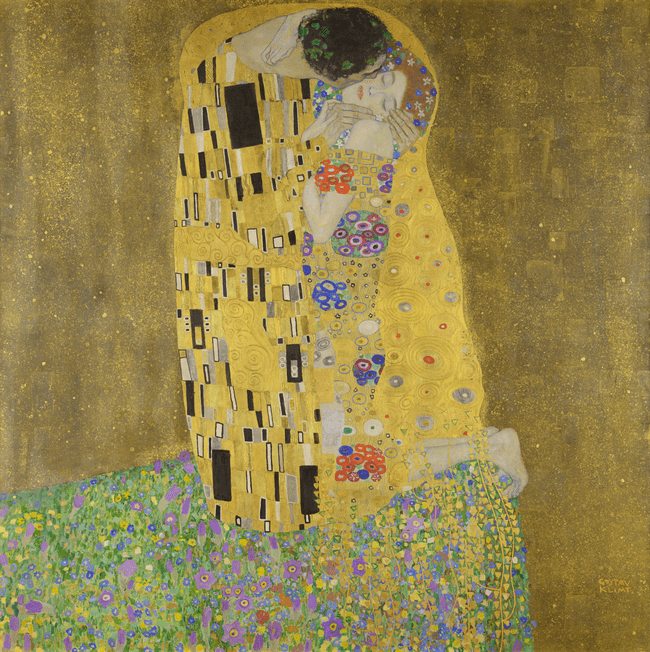
Interior Design and Sculpture
The Art Nouveau style includes the use of natural themes, ornaments, and bright colors, making it purely decorative. However, there are also examples of the use of this style in interior design. The salon–dining room of Lord Rothermere is one of them. All elements of the room are made in the same style, so each element is part of a large composition. In the formation of the company, a tree was used, which refers to natural motives. Additionally, the use of glass made it possible to create a unique play of light, which is also one of the techniques of the Art Nouveau style (“Ashby, C. (2021). Art Nouveau: Art, architecture and design in transformation. London, England: Bloomsbury Publishing”). Many panels also depict women and floral ornaments, which is typical for the movement.
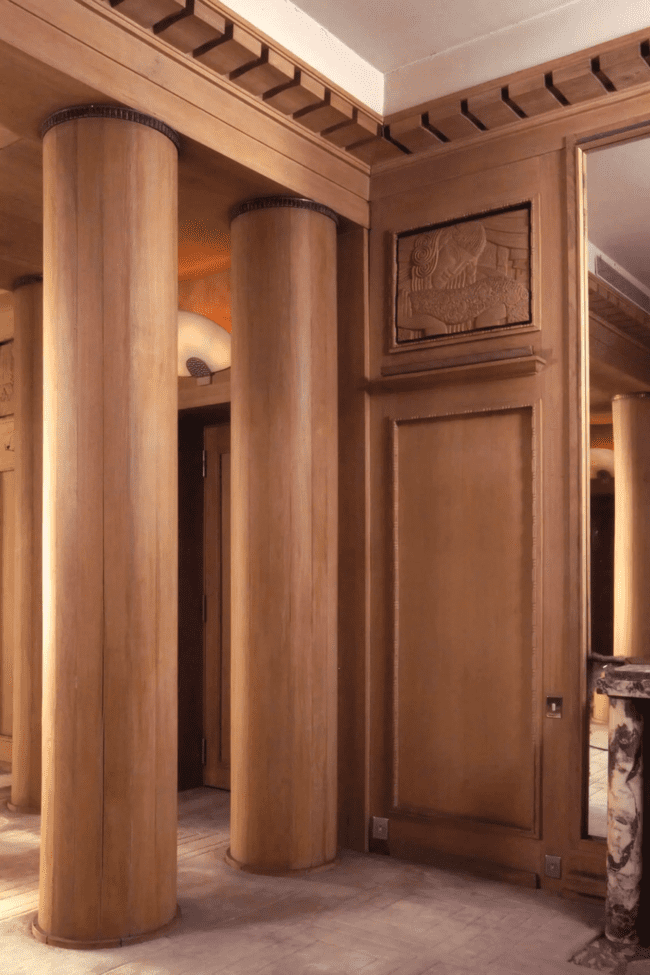
Architecture
The Art Nouveau style is also reflected in architectural works, the most famous of which are the works of Antonio Gaudí. The buildings created by the architect are typical examples of this movement, as they include natural motifs, bright colors, flowing shapes, and use the play of light as one of the decorative techniques (“Ashby, C. (2021). Art Nouveau: Art, architecture and design in transformation. London, England: Bloomsbury Publishing”). The buildings are distinguished by the active use of tiles and ceramics, which allow to create unique shapes and combinations of textures. Additionally, this architecture lacks straight lines, as walls, windows, balconies, and stairways are curved to resemble tree branches or mollusks.
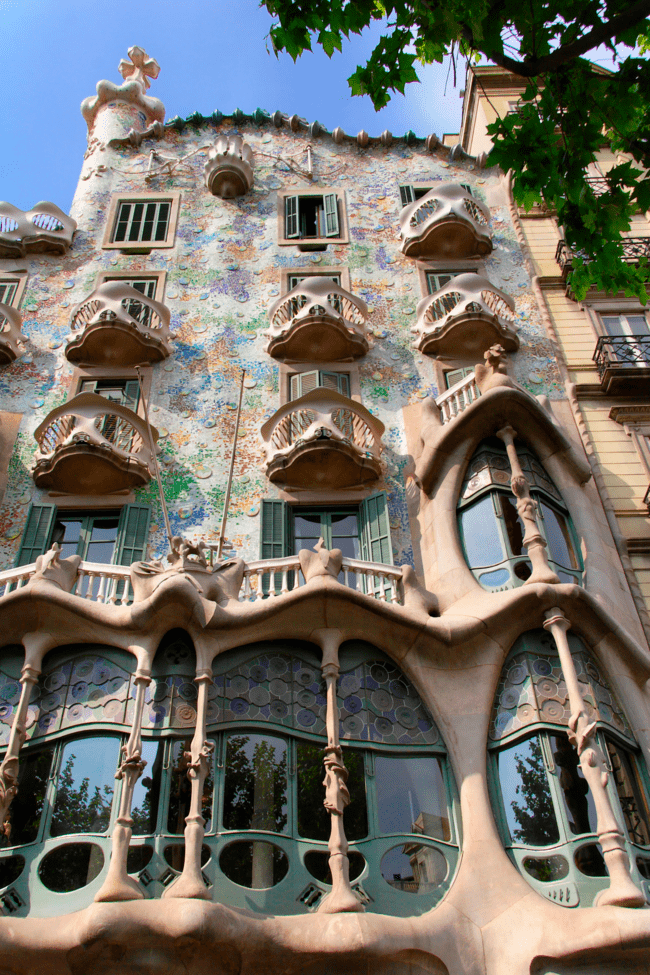
Poster Decoding
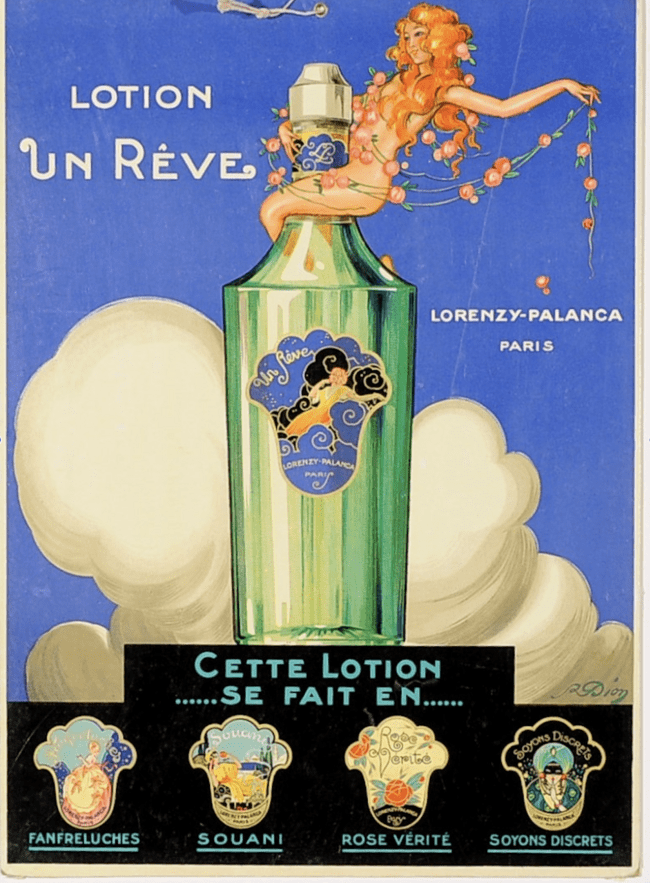
The poster that is being deconstructed is the advertisement of Lotion Un Rêve Lorenzy-Palanca Paris created by Roger Dion. It is noteworthy that the image does not look flat as is customary in the Art Nouveau style. On the poster, one can clearly distinguish the foreground with a bottle and a girl, as well as the background with clouds. This layering of objects on top of each other gives the image a bit of volume. However, the blue background still lacks the depth that is typical of the Art Nouveau style. The artist also does not depict shadows, which gives the objects a two-dimensional look.
The composition of the poster is quite standard and presents a bottle of lotion in the very center of the poster. On the neck of the bottle is placed a girl with flowing hair, which is a typical element of the Art Nouveau style (“Ashby, C. (2021). Art Nouveau: Art, architecture and design in transformation. London, England: Bloomsbury Publishing”). There are clouds in the background, which refers the viewer to the name of the lotion, which translates as a dream. The composition indicates the main marketing attributes of the object, emphasizing its lightness and associating it with beauty and youth.
The poster includes the main elements of the art nouveau style combined with the advertised product. First of all, the woman is one of the main attributes of Art Nouveau style graphics. Around the figure of a woman, one can also notice vines with flowers, which refers the viewer to floral motifs. Clouds, in addition to the decorative and compositional load, also fulfill the communicative purpose, emphasizing the characteristics of the product. There is no active ornamental background on the poster, which is compensated by many details in the female figure.
The colors presented in the poster are also related to the theme of nature, and reflect the features of the advertised product. The blue background color matches the color on the lotion label. The artist chose a creamy color for the clouds, which emphasizes their softness and airiness. The bottle is natural green, which also refers to Art Nouveau glass. The woman is executed in bright warm colors, including pink and orange, which emphasizes her youth like summer. There are contrasting colors in the poster, which unites the entire composition.
The artist used smooth curved lines, which is also characteristic of the Art Nouveau style. Even a bottle of lotion is devoid of sharp corners and straight lines. The labels on the bottle and at the bottom of the poster refer to the style’s typical peacock tail shape, which is also in keeping with the natural theme. Below one can see clear rectangular shapes that form a kind of pedestal. The artist uses this form to convey the best quality of the product, as if putting it in the first place.
The artist uses various textures, which is also characteristic of the Art Nouveau style. In particular, the bottle has a semi-transparent glass texture, which contrasts with the thick clouds in the background. Clouds have their own texture, which emphasizes their airiness but at the same time density. The texture of the girl’s skin is smooth and radiant, which emphasizes her health and youth. Overall, the poster is handcrafted with attention to detail and brushstrokes. This is also typical of the Art Nouveau style which emphasizes the connection between human and nature and focuses on the role of the creator.
The poster uses sans-serif typography, which makes it look modern. At the same time, the curves of the letters are irregular and the distance between them is different, which gives the font a handmade look. The name of the lotion is written in letters with complex curls, which refers the viewer to older typographic traditions. The use of decorative elements in the name of the lotion sets it apart from the rest of the inscriptions. Additionally, this type of font emphasizes the main idea of the product by giving the letters an older and even mythological look.
Bed Decoding
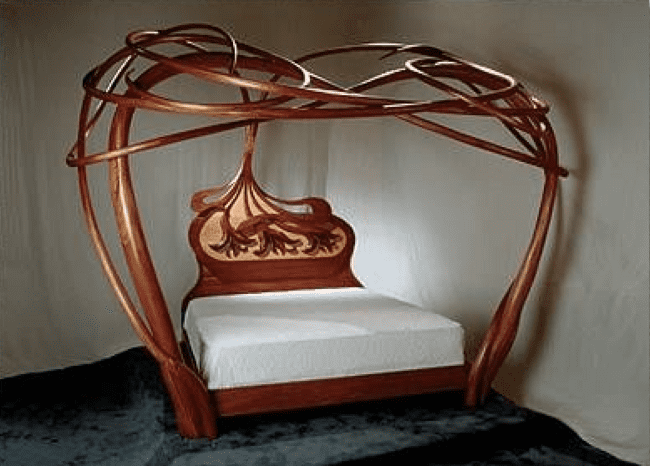
The object which is being considered is Ryan Bed created by Briggs Design and commissioned by Jody and Lisa Ryan. The shape of this bed immediately refers the viewer to the main elements of the Art Nouveau style (“Ashby, C. (2021). Art Nouveau: Art, architecture and design in transformation. London, England: Bloomsbury Publishing”). The main element of this furniture is the weave, which resembles tree branches. On the headboard one can also notice elements that are similar to the roots. The bed is both a piece of furniture and a sculpture that contains a decorative composition. The base of the bed resembles the ground from which the tree grows. Lying on this bed, people are in the canopy of the branches that are intertwined above them. There is also an image of three flowers on the headboard, which also refers to the floral motif’s characteristic of Art Nouveau.
With regard to materials, a parallel can be drawn with jewellery. The bed is made of precious wood, which is a characteristic of Art Nouveau materials (“Ashby, C. (2021). Art Nouveau: Art, architecture and design in transformation. London, England: Bloomsbury Publishing”). Art Nouveau jewelers who were moving away from the use of precious stones and metals in favor of glass, enamel, bone and other materials. In this case, the choice of materials also symbolizes the values of the Art Nouveau style, emphasizing the attraction to nature and less traditional decorative technique. In particular, the combination of different types of wood can manifest the value of closeness to nature for the Art Nouveau style.
The composition of this piece of furniture lies in the interweaving of tree branches that form a canopy. Decorative elements on the headboard in the form of flowers add ornamental embellishments, which is typical of the Art Nouveau style. Their absence would make the bed excessively plain for this style. The composition forms a transition from the lower ground to flowers and further to the crowns of trees. The base of the bed is devoid of decorative elements, which helps to focus attention on the top. The curves of the tree branches also resemble a heart, which can emphasize the theme of love in this composition.
For the bed, a combination of two contrasting shades of wood was chosen. Although the colors of the bed are natural, they look bright enough. Mahogany has a vibrant and deep brown, red color that adds to the brightness. The use of bright colors that correlate with natural tones is also typical of Art Nouveau (“Ashby, C. (2021). Art Nouveau: Art, architecture and design in transformation. London, England: Bloomsbury Publishing”). In this case, an enhanced shade of natural wood was used, which preserves its naturalness and adds decorativeness. Light oak allows one to create contrast, so that the composition with flowers looks more accentuated.
The texture of the bed is radiant and smooth, giving it a noble appearance. It is also worth noting that this wood shine interacts favorably with color, which also emphasizes the composition. Combined with color that can fall from different directions and have different characteristics, the curves of the bed take on a more embellished look. In particular, the intertwined canopy branches look more intricate and complex when exposed to light. Incorporating light into a composition to complicate it and interact with colors is also a characteristic of Art Nouveau (“Ashby, C. (2021). Art Nouveau: Art, architecture and design in transformation. London, England: Bloomsbury Publishing”). It is difficult to say whether this is the intention in this composition, but the choice of texture advantageously adds depth and variety to it.
In general, this piece of furniture is more of a sculptural piece than a functional one. As part of the interior, made in the Art Nouveau style, this item will be an accent. Despite the lack of bright colors and a variety of materials, it is the shape of the bed that gives it a unique look. The canopy of the bed has a somewhat fairy-tale feel to it, which refers to fairies and other mythical creatures living in the forests. This furniture is a vivid example of the Art Nouveau style, as it embodies all its principles. Thus, Ryan Bed is a functional sculpture that uses Art Nouveau elements.
Conclusion
The Art Nouveau style has its own distinct characteristics that can be found in many art pieces, such as paintings, jewelry, glassware, architecture, and furniture. The style is famous for its bright colors, floral patterns, the use of female figures, as well as unusual materials. The artists of this artistic movement were inspired by the natural world. They tried to create a special art movement that could bring people closer to it, as well as to give a feeling of lightness and tenderness. The style captured the beauty of nature, expressing their ideas through colors, shapes, and themes.
References
Aigner, C. J. (2020). Artistic glass: One studio and fifty years of stained glass. Ottawa, Canada: ECW Press.
Ashby, C. (2021). Art Nouveau: Art, architecture and design in transformation. London, England: Bloomsbury Publishing.
Biggs Design. (n.d). Ryan Bed. Web.
Dion, R. (1920). Advertising on cardboard “Lotion Un Rêve Lorenzy-Palanca Paris”. Web.
Gaudí, A. (1904). Casa Batlló. Barcelona, Spain. Web.
Grasset, E. (1893). Poster for Grafton Galleries. Web.
Klimt, G. (1907). The kiss [oil, gold leaf]. Österreichische Galerie Belvedere, Vienna. Web.
Lalique, R. (1897-1898). Dragonfly-woman brooch made of gold [gold, enamel, chrysoprase, chalcedony, moonstones and diamonds]. Web.
Privat-Livemont, H. (1898). Poster for biscuits and chocolate. Web.
Ruhlmann, J. E., & Rigal, L. P. (1925). The salon–dining room of Lord Rothermere [wood, mirrors, fittings]. Paris, France. Web.
Tiffany Glass & Decorating Company. (1910). Daffodil table lamp [leaded glass, patinated bronze]. Web.
Tiffany, L. C. (1905). Glass window from the Tiffany Residence at Laurelton Hall [Limestone, ceramic, and Favrile glass]. Web.
Wenzel, A. (2022). Klimt: Masters of art. Berlin, Germany: Prestel Publishing.